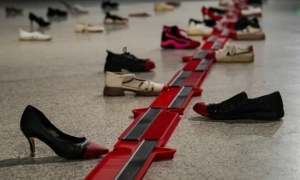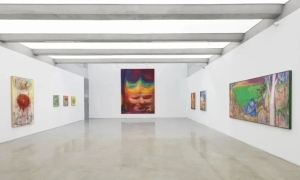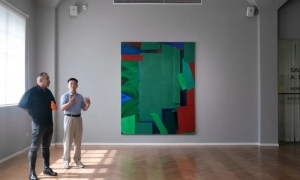前言
卡塞尔文献展没有特定的形式, 这就使得我们要将精确和宽大结合起来. 通常展览都有特定的主题或者是为某个艺术家, 某个时期或者某种风格做展览, 但是卡塞尔文献展在本质上就与此相矛盾.
第一届文献展的构思并不是为了要用当代艺术来缓解当时德国内部社会的萎靡不振. 他是非官方的, 与庆典没有多大关系的展览, 就算回到1995年, 它也只是一种带复仇思绪的审美努力. 每5年举办一次的文献展已经发展成为了当代艺术的标志, 成为了一种新的艺术形式的表达方式, 反应了一种新的谈论艺术的试验方式, 并且接受非西方思想侵入带来的改变.
举办一届没有确定形式的文献展意味着会遭遇到强烈的质疑. 但是展览本身的魅力以及它所带给大家的期望却也很高. 这是因为大家都不知道要怎样来应对这样的未知形式. 他们试图在努力寻找的过程中感受挑战, 但是怎样在辨识和固位之间保持平衡呢? 艺术能告诉我们规则. 突出艺术家的名字,向所有的概念屈从不是我们的目的, 并且我们也不赞成地理政治学的同一性. 相比其他艺术家来说, 某些艺术家对我们来说仍然有很大的意义, 并且特定的一些主题还是很有价值. 不过事实就是, 艺术和历史有关联, 每一件艺术作品背后都有一个相应的历史. 但是如果我们去掉预先设定的类别并且能达到一个艺术本身能用艺术术语相互交流的高度的话,这样的展会还是很值得一看的.这是一个真正意义上的审美经历: 展览本身已经变成了媒介, 并且能将观众真正融入其中.
不过我们怎样才能在这个高度上面运作自如呢? 所有的目录都是按照时间的先后排序,而不是按照字母来排序的. 在这个时间线索中某些作品很突出, 同时也能在后面找到所有艺术作品的列表.我们甚至从很早期的作品中选择这些艺术品. 尽管这个看起来好像很怪, 因为卡塞尔文献展是一个当代艺术展,不过我们相信大多的艺术形式的形成都必须要经历一个很长的历史过程. 说不定在将来也能发展的很好. 艺术家们都很清楚他们现在所使用的这些艺术形式和将来可能的情况. 但是观众们不清楚. 如此对我们来说, 在理论上以及实实在在的展出所有形式的内在定论并且让他们体现在第12届文献展中非常有意义.
完成一个展览仅仅靠一两个人肯定是不行的. 并且没有灵感,我们无疑没有办法完成他们的激情和实现对他们的诺言. 为保持文献展无特定形式的特性, 我们不会顾及到参与准备个体的方方面面. 尽管如此, 我们也很愿意利用这个机会去感激所有的艺术家和顾问们. 也很感激为这个展览花了3年时间的团队. 同时还要感激支持我们的管理层,即使是在难于决策的时候他们仍然很支持我们, 以及给予文献展巨大支持的以Kulturstiftung des Bundes为代表的政府部门, 市长, 海森联邦政府以及德国政府. 感谢第12届文献展的顾问团队,他们让我们在卡塞尔感觉像在自己的家乡一样自在, 以及文献展杂志的编辑部门, 他们在全球范围内都给我们很大的帮助. 第12届文献展国际理事会, 以及第12届文献展中给予我们巨大支持的个人. 总之, 我们要感谢那些所有的支持文献展的人, 我们的赞助商,我们的媒体合作者, 我们的出版商.
Preface
The big exhibition has no form. This trivial fact made us seek to combine precision with generosity. More often than not exhibitions come with a theme or are dedicated to a particular artist, a certain era or style, however the documenta’s inherent formlessness contradicts any such approach.
The first documenta was conceived out of a desire to reconcile a demoralized German civil society with Modern art. Yet the first exhibition had nothing much official or celebratory about it; even back in 1995 it was an aesthetic effort with a vengeance. Reappearing every five years, documenta has subsequently developed into a cipher of contemporary art, as an image it has adapted itself to new modes of artistic expression, it has reflected experimental ways of speaking about art, and it has allowed itself to be changed by the influx of non-western thought.
To do documenta, an exhibition without form, means entering a field of highly contradictory forces. The fascination emanating from the show, as well as the expectations it raises are enormously high. This is due to the fact that people are not really well equipped to deal with radical formlessness. They tend to feel the challenge by seeking for identity. But how does one keep the balance between identification and fixation? Art can teach us this discipline. It was not our aim either to highlight artists’ names or to succumb to all-encompassing concepts, nor did we want to favor geopolitical identity. Naturally certain artists matter to us more than others and of course particular concepts remain essential. It is equally true that art is not without context; each work is attached to a local history. However, exhibitions are only worth looking at if we manage to dispense with preordained categories and arrive at a plateau where art communicates itself and on its own terms. This is aesthetic experience in its true sense: The exhibition becomes a medium in its own right and can thus hope to involve its audience in its compositional moves.
But how can we navigate on this plateau? The catalogue entries follow a time line rather than alphabetical order. Certain works are highlighted within this time line, while the complete checklist of the art works can be found at the back. With our choice of the works we have moved deeply into the past. Although this might look odd considering that documenta is an exhibition of contemporary art, we believe that it is necessary that because most forms and formats come with rather a long history. They may also extend well into the future. Artists are highly aware of both the history of the forms they are using as well as of their future implications. The audience is generally not. It made sense, to us, to approach the internal dynamic destinies of form not only theoretically but to actually show them, turning them into documenta 12.
An exhibition is not created by one or two people alone. Without the inspiration, the engagement and the passion of others we would doubtlessly have failed. In keeping with decumenta’s formlessness we are refraining from mentioning every single individual that took part in the preparations. This notwithstanding, we’d like to use this opportunity to thank the artists and our advisors. Deep gratitude goes to the team that has spend three years working on the exhibition. We are eternally grateful to our management for supporting our ideas even when decisions were difficult, as well as to the governing body of documenta GmbH, that is the city of Kassel with its mayor, the federal state of Hessen and the German government, represented by the Kulturstiftung des Bundes. We thank the documenta 12 Advisor Board, which made us feel at home in Kassel, the editorial boards of ducumenta Magazines, who welcomes us around the globe, the international Council of Documenta 12, and those individuals who have supported us as “pillars” of documenta 12. Finally, we would like to thank those who lent us exponents for the exhibition, our sponsors, our media partners and our publisher. We dedicate this exhibition to our two children Charlotte and Kasimir, who have coped valiantly with their parent’s often-lengthy meanderings.

























